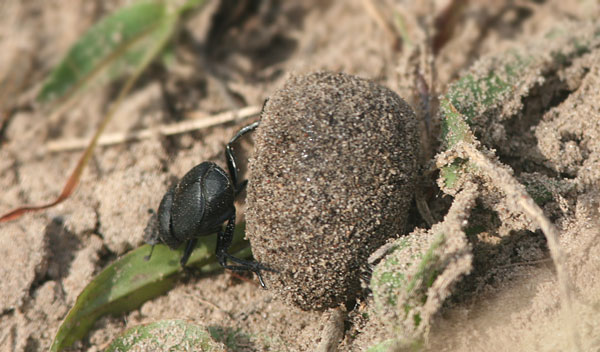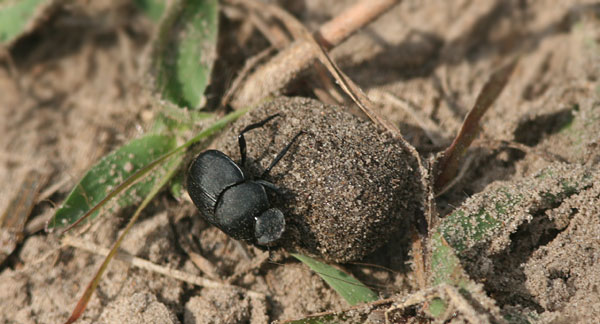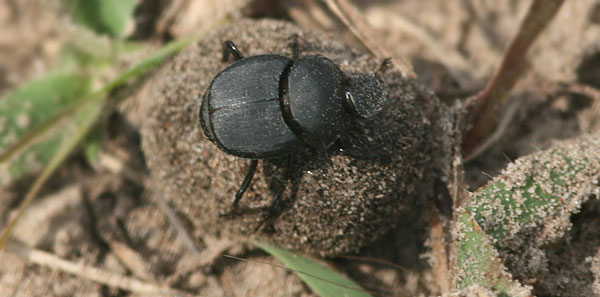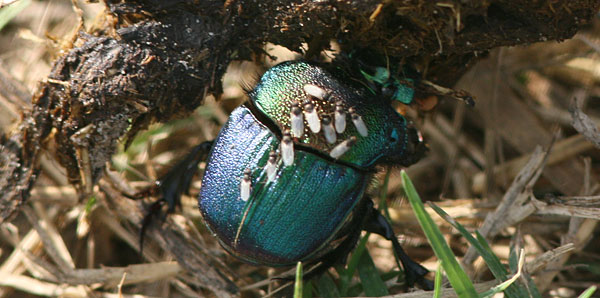I am so excited about the announcement of Ted C. MacRae‘s new beetle-based blog carnival, An Inordinate Fondness that I delved into the vault for a special post for its inaugural issue on February 10. Ladies and gentlemen, I bring you… DUNG BEETLES!
Yes, only the best beetles know their way around a dollop of dung. Texas’ Rio Grande Valley, which I visited in November 2008, is brilliant not only for birds, butterflies, and sometimes even birders, but basically every other kind of creature that creeps, crawls, slithers, or flies. For example, who knew that the Lone Star State enjoyed such a diversity of dung beetles? I certainly didn’t until I visited the historic King Ranch, spotting not one, but two different types of beetle.

The first waste-wrangler I found was what I thought to be a Northern Malagoniella-Scarab (Malagoniella astyanax). However, Ted politely pointed out that those scarabs are large and shiny, whereas this beetle bears the hallmarks of a Canthon lecontei, which apparently doesn’t have a common name. This species is currently known only from south Texas.

Why do they do it… “it” being both eating dung and rolling it into pretty poop balls? Dung beetles craft fresh fecal matter into proportionally monstrous spheres or ovoids (using their legs and mouth parts — yikes!) in order to roll them into their underground nests. The dung hen will then lay one egg into each dung ball, ensuring her lucky larva a fecal feast upon hatching. Have you ever been so glad to be born a human?

Of course, without dung beetles and their ilk, we may be buried under mountains of manure. I won’t go so far as to recommend you kiss a dung beetle today but at least show a little respect and gratitude! Dung beetles, all in the superfamily Scarabaeoidea, range from merely impressive (try to roll a ball of dung three times your size and tell me how far you get) to magically gorgeous. The following Rainbow Scarab (Phanaeus vindex) is absolutely scintillating. You can tell this beetle is a female due to her absence of horn. What I can’t tell, however, is what manner of bug is perched on her back. I can only imagine they share her interest in dung.

Rainbow Scarab (Phanaeus vindex)



 New writers welcome – please contact us for details.
New writers welcome – please contact us for details.

















Did North America have bigger dung beetles in the past to deal with the bigger dung droppers or are these guys just seriously underworked these days? Inquiring/nerdy minds want to know.
How did I miss these guys on my recent trip home to bird in the RGV? Next time, Mike, next time!
Tai Haku, I don’t even want to conjecture down that path…
Delia, now that you know about these beetles, you’ll find them for sure!
Not long ago some 30 myo “fossil” dung balls the size of tennis balls were discovered in South America, so likely there were larger dung beetles in the past associated with the Miocene megafauna. Interestingly, dung beetles as a group are thought to have appeared only 40 mya – after the demise of the dinosaurs. Makes one wonder what happened to all that dinosaur poop!
Riley and Wolfe (2003) list about 38 spp of dung beetles (Scarabaeinae) for south Texas.
If ya wanna branch out beyond dung beetles (and who doesn’t?!), Riley and Quinn (2009) list just over 1000 beetles for the sabal palm grove sanctuary near Brownsville:
But for the greatest documented Nearctic beetle diversity, one needs to travel north (!) to Latimer County, Oklahoma (!!) where Karl Heinz Stephan (1931-2005) recorded just over 3,500 spp. (!!!) Thus, Karl documented about as many beetles in one county in Oklahoma as there are birds in all of South America… Mike Quinn, Austin (Hope I got all the xhtml code right…)
Actually, I am quite enamored of dung beetles. They are wonderful contributors to the ecology of farm country in the mid-Atlantic (wet spring and fall, hot humid summers, cold, snowy winters), but the population seems to have dwindled over the past five years. I would like to start doing dung beetle husbandry (I have an endless supply of food for them), if anyone knows where I can purchse some live beetles. I would like to share them with other farmers in my area. Thanks for any suggestions!
It was fun to happen upon this post. As a child in the Abilene, TX area, I would happily watch dung beetles all afternoon, wondering why they did this, and how far they were going. My brother and I called them tumble-bugs. We thought they were worthy of observation; so glad you do, too!
where can I purchase the onthophagus gazella fabricius dung bettle